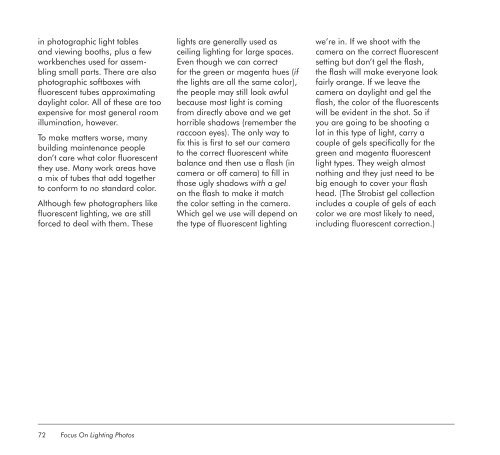Focus On Lighting Photos Focus on the Fundamentals.pdf
You also want an ePaper? Increase the reach of your titles
YUMPU automatically turns print PDFs into web optimized ePapers that Google loves.
in photographic light tables<br />
and viewing booths, plus a few<br />
workbenches used for assembling<br />
small parts. There are also<br />
photographic softboxes with<br />
fluorescent tubes approximating<br />
daylight color. All of <strong>the</strong>se are too<br />
expensive for most general room<br />
illuminati<strong>on</strong>, however.<br />
To make matters worse, many<br />
building maintenance people<br />
d<strong>on</strong>’t care what color fluorescent<br />
<strong>the</strong>y use. Many work areas have<br />
a mix of tubes that add toge<strong>the</strong>r<br />
to c<strong>on</strong>form to no standard color.<br />
Although few photographers like<br />
fluorescent lighting, we are still<br />
forced to deal with <strong>the</strong>m. These<br />
72 <str<strong>on</strong>g>Focus</str<strong>on</strong>g> <str<strong>on</strong>g>On</str<strong>on</strong>g> <str<strong>on</strong>g>Lighting</str<strong>on</strong>g> <str<strong>on</strong>g>Photos</str<strong>on</strong>g><br />
lights are generally used as<br />
ceiling lighting for large spaces.<br />
Even though we can correct<br />
for <strong>the</strong> green or magenta hues (if<br />
<strong>the</strong> lights are all <strong>the</strong> same color),<br />
<strong>the</strong> people may still look awful<br />
because most light is coming<br />
from directly above and we get<br />
horrible shadows (remember <strong>the</strong><br />
racco<strong>on</strong> eyes). The <strong>on</strong>ly way to<br />
fix this is first to set our camera<br />
to <strong>the</strong> correct fluorescent white<br />
balance and <strong>the</strong>n use a flash (in<br />
camera or off camera) to fill in<br />
those ugly shadows with a gel<br />
<strong>on</strong> <strong>the</strong> flash to make it match<br />
<strong>the</strong> color setting in <strong>the</strong> camera.<br />
Which gel we use will depend <strong>on</strong><br />
<strong>the</strong> type of fluorescent lighting<br />
we’re in. If we shoot with <strong>the</strong><br />
camera <strong>on</strong> <strong>the</strong> correct fluorescent<br />
setting but d<strong>on</strong>’t gel <strong>the</strong> flash,<br />
<strong>the</strong> flash will make every<strong>on</strong>e look<br />
fairly orange. If we leave <strong>the</strong><br />
camera <strong>on</strong> daylight and gel <strong>the</strong><br />
flash, <strong>the</strong> color of <strong>the</strong> fluorescents<br />
will be evident in <strong>the</strong> shot. So if<br />
you are going to be shooting a<br />
lot in this type of light, carry a<br />
couple of gels specifically for <strong>the</strong><br />
green and magenta fluorescent<br />
light types. They weigh almost<br />
nothing and <strong>the</strong>y just need to be<br />
big enough to cover your flash<br />
head. (The Strobist gel collecti<strong>on</strong><br />
includes a couple of gels of each<br />
color we are most likely to need,<br />
including fluorescent correcti<strong>on</strong>.)



